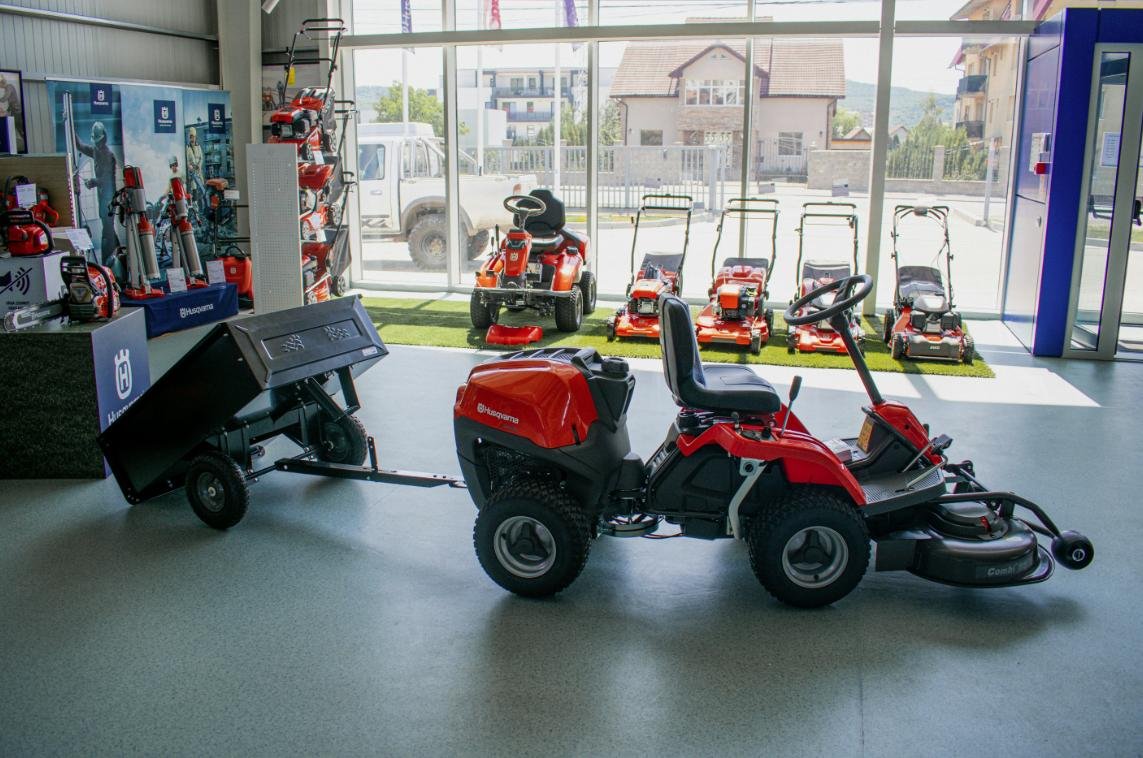Understanding Your Lawn Care Needs
Choosing the right lawn mower begins with a thorough assessment of your specific lawn care needs. The first factor to consider is the size of your lawn. Larger lawns typically require mowers with wider cutting decks and more horsepower to efficiently cover ground and reduce mowing time. Conversely, small lawns may benefit from compact, lightweight models that are easier to maneuver in tight spaces. Evaluating your lawn’s dimensions will guide you in selecting a mower that balances efficiency and effective grass maintenance.
Another critical element to assess is the terrain of your lawn. If your property has hilly areas, you may need a mower that offers stability and traction to navigate inclines without compromising performance. Additionally, uneven or rocky landscapes might necessitate a mower designed to handle rugged conditions, ensuring consistent cut quality and durability over time. Identifying the unique characteristics of your terrain allows for more informed decision-making when selecting the appropriate lawn mower.
Furthermore, understanding the type of grass in your lawn is essential for determining mowing frequency and cutting height. Different grass varieties have unique growth patterns and height requirements, which should influence how often you mow. For instance, cool-season grasses may require cutting every week during their active growth period, while warm-season grasses might thrive on a more relaxed schedule. It’s also vital to consider the ideal cutting height, as this can significantly impact the health of the grass and overall lawn appearance. By taking these factors into account—lawn size, terrain, and grass type—you will lay a strong foundation for choosing a mower that effectively meets your lawn care needs.
Types of Lawn Mowers Explained
Choosing the right lawn mower is a critical decision for maintaining a healthy and aesthetically pleasing lawn. Understanding the various types of lawn mowers available can help homeowners make an informed selection tailored to their needs.
Manual reel mowers are a traditional option that operates without electricity or gas. These mowers are powered by human effort, using a cylinder of blades that cuts the grass as you push it. The advantages include their eco-friendliness, quiet operation, and low maintenance costs. However, they can be less effective on uneven or overgrown lawns.
Electric mowers come in two main varieties: corded and cordless. Corded electric mowers are limited by the length of the power cord but are usually lighter and require less maintenance than gas-powered options. They are ideal for small to medium lawns. On the downside, the cord can be cumbersome during operation. Cordless electric mowers, powered by rechargeable batteries, offer greater mobility and convenience. However, they may have limited run times before requiring a recharge, which could impede larger mowing tasks.
Gas mowers are known for their power and effectiveness on larger areas of grass. They typically possess stronger engines, allowing them to handle thick, overgrown lawns. Although they provide excellent cutting performance, gas mowers have higher maintenance costs due to fuel and oil changes, and they produce noise and emissions, raising environmental concerns.
Riding mowers are designed for larger properties, offering comfort and efficiency. They can navigate rough terrain with ease and often come with various attachments for added functionality. However, their cost can be substantial, making them less accessible for homeowners with smaller lawns.
In conclusion, understanding the various types of lawn mowers, along with their advantages and disadvantages, can significantly aid in making an informed choice that aligns with individual lawn care needs and preferences.
Power Source Options: Electric vs. Gas vs. Manual
When selecting a lawn mower, one of the most crucial decisions involves the power source. The three primary options are electric, gas, and manual mowers, each with its unique characteristics and implications for users.
Electric lawn mowers have gained popularity due to their ease of use and environmental advantages. They come in corded and cordless models, providing flexibility in maneuverability. Cordless models typically operate on rechargeable batteries, eliminating the need for gasoline and reducing emissions, which appeals to environmentally conscious homeowners. Maintenance requirements for electric mowers are generally lower as they do not require frequent oil changes or filter replacements common in gas models.
On the other hand, gas-powered lawn mowers are known for their performance, particularly in larger yards where more power is needed. These mowers tend to cut through thick grass and dense terrain with ease. However, they do require more maintenance, including regular checks on the engine, oil changes, and fuel management. In addition, gas mowers produce emissions that can be harmful to the environment, making them less desirable for consumers who prioritize sustainability.
Manual mowers, commonly referred to as reel mowers, provide a nostalgic and eco-friendly option. These mowers operate purely through human power and are ideal for small lawns. Manual mowers require minimal maintenance—sharpening the blades occasionally is typically sufficient. Their silent operation and zero emissions make them a perfect choice for environmentally responsible lawn care. However, they may not suit every user, particularly those with larger or uneven terrain where more robust options could be more effective.
In considering the power source for a lawn mower, factors such as environmental impact, maintenance requirements, performance, and initial costs play significant roles. Homeowners should evaluate these aspects in light of their lawn care needs and personal preferences to choose the option that best aligns with their lifestyle.
Key Features to Consider
When selecting the right lawn mower, it is imperative to consider several key features that can greatly influence performance and user satisfaction. First and foremost, the cutting width is a vital aspect to evaluate. A wider cutting deck typically allows for quicker mowing of larger areas; however, narrower decks may provide better maneuverability in tight spaces and intricate landscaping. Depending on the size of your lawn, choosing an appropriate cutting width can save time and ensure a well-manicured appearance.
Another significant feature to contemplate is adjustable cutting heights. Different grass types and growth patterns require varied cutting heights, which can affect the health and aesthetics of your lawn. A mower that offers adjustable height settings allows users to customize the cut according to their specific needs. This flexibility ensures that your mower can adapt as seasonal growth occurs.
Ease of use is of paramount importance, particularly for those who may not have extensive experience with lawn care equipment. Features such as self-propulsion, electric start, and lightweight designs can make the mowing process more enjoyable and less physically demanding. A mower designed with user-friendly controls will allow anyone, from novices to seasoned gardeners, to operate it efficiently.
Lastly, the durability of the mower cannot be overlooked. High-quality materials and construction are essential for longevity, particularly if the mower will be frequently used. Researching customer reviews and manufacturer warranties can provide insights into the reliability of various models, ensuring that your investment stands the test of time.
By carefully considering these key features—cutting width, adjustable heights, ease of use, and durability—homeowners can select a mower that best suits their lawn care needs and personal preferences.
Budgeting for Your Lawn Mower
When embarking on the journey of purchasing a lawn mower, establishing a budget is a crucial first step. The financial implications extend beyond the initial purchase price, encompassing ongoing maintenance, fuel expenses, and potential repairs. A comprehensive understanding of these costs is essential to make an informed decision and strategize effectively for your lawn care investment.
Upfront costs vary significantly based on the type of lawn mower you choose. For instance, manual reel mowers generally come at a lower price point compared to gas-powered or electric models. Yet, the higher initial investment in a more advanced mower may yield better results in the long term. It is vital to evaluate your lawn size, terrain, and the mower’s features to determine a suitable price range. Consider allocating a portion of your budget for necessary accessories, such as grass bags and maintenance tools, which can enhance the mower’s effectiveness and lifespan.
The ongoing maintenance of the mower is another aspect that will affect your budget. Regular blade sharpening, oil changes, and seasonal tuning are necessary to keep the machine in peak operation. Additionally, consider your fuel costs if you opt for a gas-powered mower; these expenses can add up over time. Electric mowers may have lower running costs, but it’s essential to factor in the expense of replacing batteries, if applicable.
Lastly, think about potential long-term savings associated with your choice of lawn mower. Investing in a higher-quality product may seem costly initially, but it can lead to reduced repair needs and increased durability. Moreover, a well-maintained mower can significantly improve the quality of your lawn, leading to potential increases in property value. Strategically assessing both short-term and long-term costs will facilitate a more prudent investment in your lawn care endeavor.
Evaluating Brand Reliability and Reviews
When selecting a lawn mower, understanding the reliability of various brands is essential to make an informed decision. The lawn mower market is filled with multiple manufacturers, each claiming their product is the best. Therefore, conducting thorough research on each brand becomes paramount. Start by identifying the well-established brands known for their quality and longevity. Often, these reputable manufacturers have years of experience and a proven track record in the gardening industry.
Reading customer reviews is an effective way to gauge brand reliability. Several online platforms allow consumers to share their experiences with specific lawn mower models. Look for aggregated ratings as well as detailed feedback to understand the strengths and weaknesses of each mower. Pay attention to recurring themes in the reviews, such as ease of use, maintenance, and durability, as these factors significantly affect your overall satisfaction with the purchase.
Additionally, warranty options provided by manufacturers can serve as a crucial indicator of their confidence in their products. A robust warranty often reflects the brand’s commitment to quality and customer satisfaction. When comparing different models, check the warranty duration and the terms covered. Brands that offer extended warranties may signal a reliable and durable product. Lastly, consult lawn mower forums and social media groups to get unfiltered opinions from experienced users. Engaging with a community of lawn care enthusiasts can provide valuable insights that can not be easily found in advertisements.
Incorporating these strategies will empower you to evaluate brand reliability efficiently and make a purchase that aligns with your needs. Emphasizing research and reviews ensures that your chosen lawn mower will not only meet your expectations but also enhance your lawn care experience.
Maintenance Tips for Your Lawn Mower
Maintaining your lawn mower is essential to ensure its longevity and optimal performance. Regular upkeep not only enhances the efficiency of the mower but also ensures your lawn remains healthy and beautifully manicured. Here are several key maintenance tips to consider.
First and foremost, proper storage is critical. After each use, make it a point to clean your mower and store it in a dry, sheltered location. This prevents rust and corrosion, which can significantly impair the mower’s functionality over time. If storing for an extended period, consider using a fuel stabilizer to prevent fuel degradation.
Cleaning is another vital aspect of maintenance. Debris such as grass clippings and dirt can accumulate on the mower’s deck and undercarriage, potentially affecting its performance. A routine inspection and thorough cleaning after mowing sessions will not only help maintain efficiency but also prevent potential damage. Use a wire brush or a putty knife to remove tough build-up and rinse with water, being cautious with electrical components.
Blade sharpening should also be prioritized. Dull blades can tear grass rather than cut it cleanly, leading to a stressed lawn that may be susceptible to pests and diseases. Aim to sharpen the blades at least once per season or as needed. Regular inspection will help ascertain their condition. If you’re not comfortable sharpening the blades yourself, consider professional services as part of your maintenance routine.
Lastly, conducting seasonal checks is advisable. Before the mowing season begins, examine your mower’s oil levels, filters, and spark plugs. Changing the oil and replacing clogged or dirty filters will enhance the engine’s performance. These simple maintenance tasks will ensure your lawn mower operates smoothly throughout the growing season, allowing you to achieve the best results for your lawn.
Sustainable Lawn Mowing Practices
As awareness of environmental issues grows, it is essential to adopt sustainable lawn mowing practices that not only preserve our ecosystems but also enhance the quality of our lawns. One of the most effective methods is mulching. This technique involves using a mower equipped with a mulching blade to finely chop grass clippings, which can then be redistributed across the lawn. By doing so, these clippings return vital nutrients to the soil, promoting healthier grass growth and decreasing the need for synthetic fertilizers.
Another eco-friendly option is the use of electric lawn mowers. Unlike gas-powered mowers, electric models produce significantly fewer emissions, contributing to better air quality and reducing the carbon footprint associated with lawn care activities. Additionally, electric mowers tend to operate more quietly, reducing noise pollution in residential areas. For those looking to further minimize their environmental impact, consider investing in cordless battery-operated mowers, which offer the flexibility of mobility without the limitations of cords.
Proper grass handling is another critical aspect of sustainable lawn mowing practices. Maintaining the recommended cutting height for your specific grass type can help prevent stress on the lawn, allowing for deeper root systems and healthier growth. During dry spells, it is advisable to leave the grass slightly longer, as this shade can help retain soil moisture. Furthermore, mowing during the cooler parts of the day—such as early morning or late afternoon—reduces stress on both the grass and the mower, resulting in a more efficient mowing process.
By integrating these sustainable practices into your lawn care routine, you contribute positively to the environment while achieving a lush and vibrant lawn. Embracing eco-friendly lawn mowing strategies leads to a more sustainable approach to lawn care, fostering healthier grass and reducing our collective environmental impact.
Making the Final Decision
Choosing the right lawn mower requires careful consideration of several key factors to ensure that you select a model that aligns with your specific needs. As we conclude this guide, it is essential to recap the critical aspects that should influence your decision-making process.
Firstly, assess the size of your lawn. For smaller yards, a push mower may suffice, while larger spaces often necessitate a riding mower for efficiency and comfort. Next, consider the terrain of your lawn. If your yard has uneven terrain or obstacles, a mower with good maneuverability will be beneficial. Additionally, evaluate the grass type and growth rate, as certain mowers handle thick or coarse grasses better than others.
The power source is another vital aspect. Gas mowers offer more power and longer run times, making them ideal for extensive properties. However, electric and battery-operated mowers are quieter, environmentally friendly, and often easier to maintain, which suits smaller lawns. Furthermore, take into account your physical ability. If you require a mower that demands less physical exertion, models with self-propulsion features may be more appropriate.
To facilitate your decision-making, consider using a checklist or a decision matrix. This can help you weigh various factors, such as lawn size, terrain type, power source, maintenance requirements, and personal comfort. By organizing these considerations visually, you can prioritize which features are non-negotiable and which are flexible.
Ultimately, take your time to research different options, comparing features and prices to find the best fit. Empower yourself with knowledge and confidently choose a lawn mower that will meet your needs for years to come.






